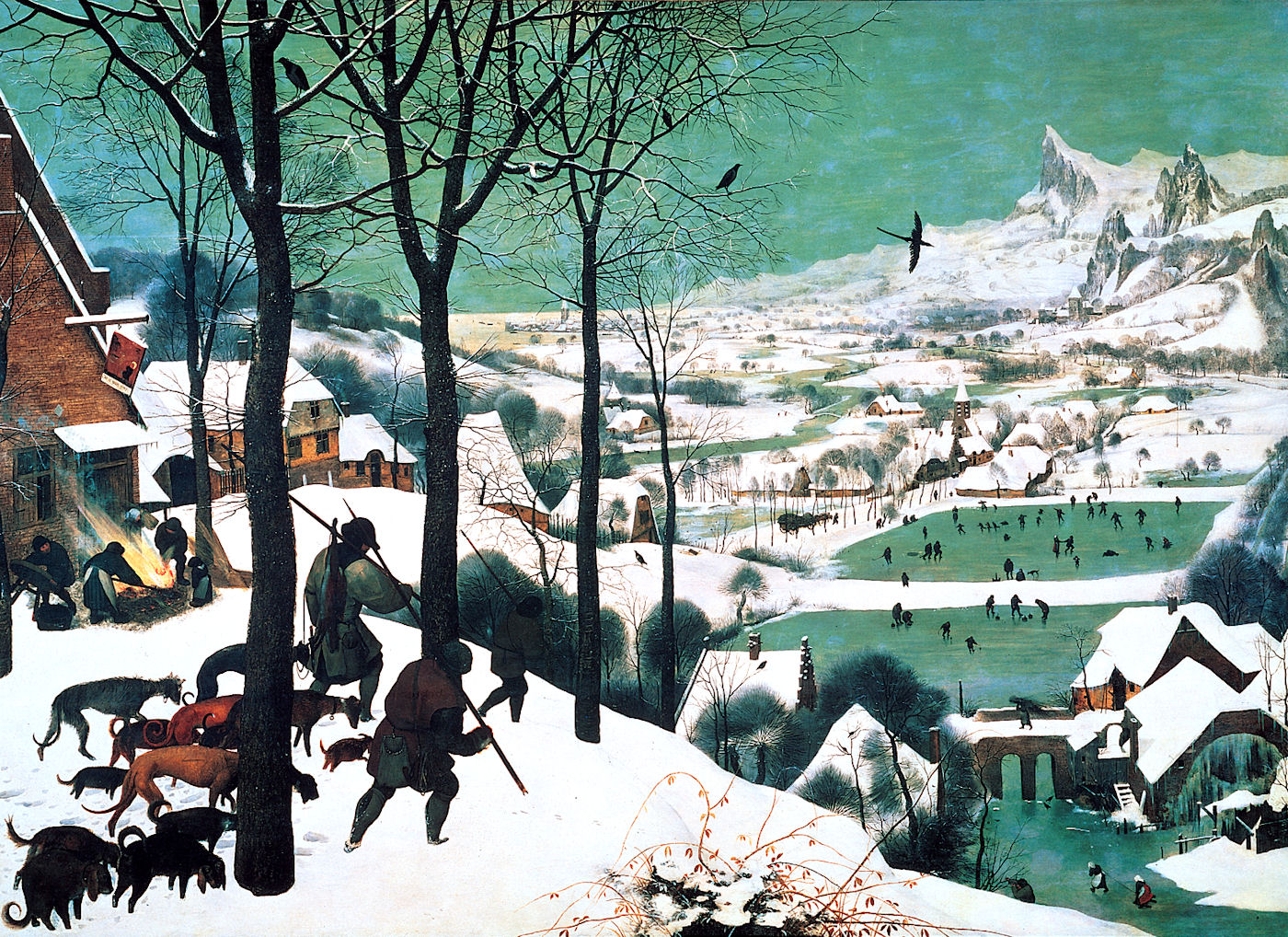Legends
home
From a desert, from the driest continent, from this land at the opposite end of the globe ...
... as remote as could be in the hockey world ...
... came one of the world’s oldest winter sports trophies.
A cool tradition, a dream of champions, and a story we owe it to our children to tell.
Legends of Australian Ice.
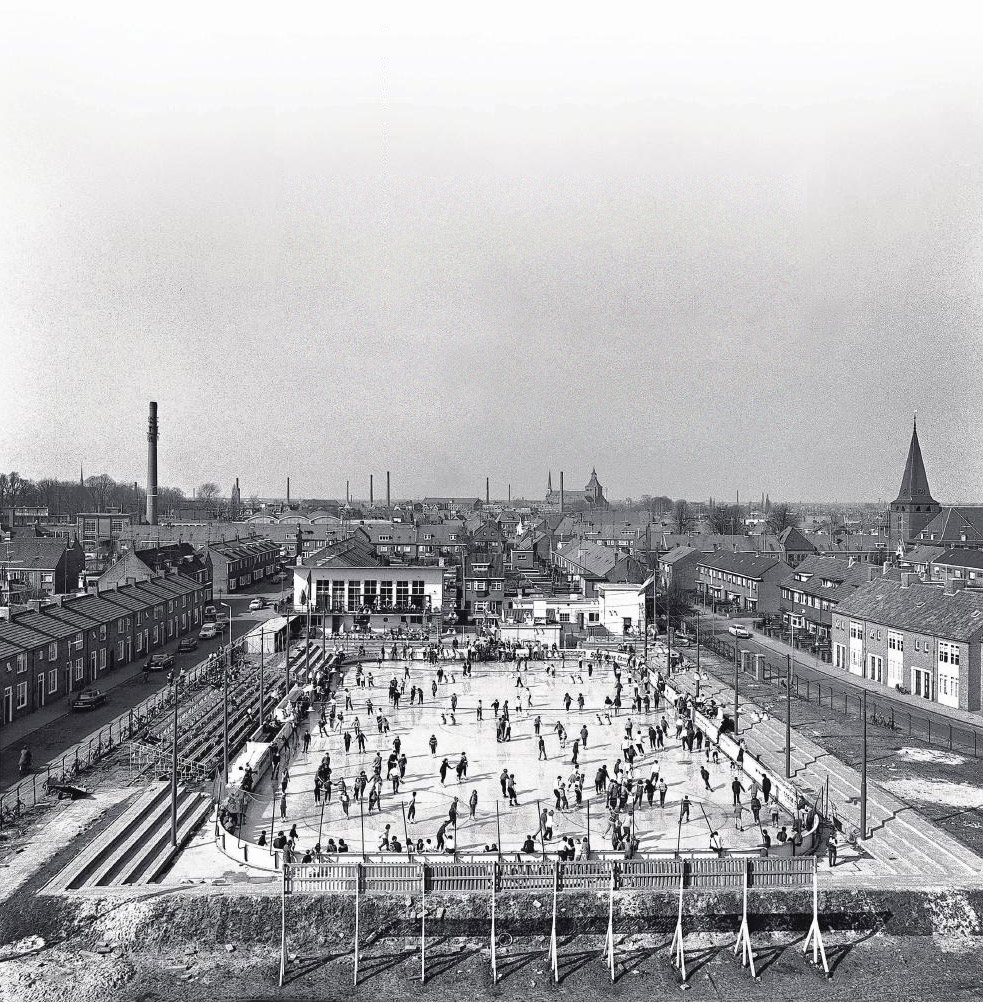
Tilburg's second engineered ice rink, built 1963 in Parochie Theresia, covered 1969. Tilburg Trappers 75-year Hockey History, cover. Brabants Dagblad 2013. [12]
[ ICE HOCKEY ] The Pirate of Tilburg
Franciscus van Rijswijk (1932 - 2014)
![]() TIJSC (Tilburgsche Ice Sports Club) was founded on October 21, 1938 and officially recognized on January 18, 1939. At that time the club had 20 members. The official opening of the ice rink was on December 8, 1938 with a match between The Hague and a team from Belgium. The first TYSC hockey game was played on March 3, 1939 against a team from Brussels. Brussels won the match 6-2. The highlight of the 1938-1939 season, however, was the exhibition game on February 24, 1939, under appalling conditions, between the Canadian champion The Trial Smoke Eaters and the American national team. It was a big promotional stunt for Tilburg hockey and the match was won by the Trial Smoke Eaters, 2-1. [1]
TIJSC (Tilburgsche Ice Sports Club) was founded on October 21, 1938 and officially recognized on January 18, 1939. At that time the club had 20 members. The official opening of the ice rink was on December 8, 1938 with a match between The Hague and a team from Belgium. The first TYSC hockey game was played on March 3, 1939 against a team from Brussels. Brussels won the match 6-2. The highlight of the 1938-1939 season, however, was the exhibition game on February 24, 1939, under appalling conditions, between the Canadian champion The Trial Smoke Eaters and the American national team. It was a big promotional stunt for Tilburg hockey and the match was won by the Trial Smoke Eaters, 2-1. [1]
![]() The scenes in Tilburg during the next 36 hours baffle description. It was the Father and Mother of all liberation parties. The people really broke out. They kissed and hugged every British soldier, they showered gifts on them, they cheered, they cried, the children by magic appeared with orange ribbons in their hair; thousands of Dutch tricolours were everywhere; all houses were open to the Red Lions (as the men of the Division came to be called), and all the drinks were free. On the Saturday night, October 28th, the frenzy of the crowd rose to a new pitch. The pipe band of 6th Royal Scots Fusliers marched into the main square and played selections. They were mobbed; the national anthems were sung over and over again and all the old songs like Tipperary; the people danced and sang for hours. It was mafficking on a grand scale and brought tears to the eyes of many a hardened soldier. The Lowland Brigade will never forget Tilburg.
From Normandy To The Baltic, 1951, Field Marshal Bernard L. Montgomery (or as authored, The Viscount Montgomery of Alamein)
The scenes in Tilburg during the next 36 hours baffle description. It was the Father and Mother of all liberation parties. The people really broke out. They kissed and hugged every British soldier, they showered gifts on them, they cheered, they cried, the children by magic appeared with orange ribbons in their hair; thousands of Dutch tricolours were everywhere; all houses were open to the Red Lions (as the men of the Division came to be called), and all the drinks were free. On the Saturday night, October 28th, the frenzy of the crowd rose to a new pitch. The pipe band of 6th Royal Scots Fusliers marched into the main square and played selections. They were mobbed; the national anthems were sung over and over again and all the old songs like Tipperary; the people danced and sang for hours. It was mafficking on a grand scale and brought tears to the eyes of many a hardened soldier. The Lowland Brigade will never forget Tilburg.
From Normandy To The Baltic, 1951, Field Marshal Bernard L. Montgomery (or as authored, The Viscount Montgomery of Alamein)

TIJSC on the ice at the rink next to the ice factory on Elzenstraat in 1938. [12]
MANY YEARS LATER, as he gazed at the blazing red emptiness of the Australian desert, Frans van Rijswijk was to remember that distant afternoon when his father took him to discover ice. The frozen canals and the pond in Tilburg Park were his universe and as infinitely vast, their surfaces merging with the wintry white heavens on a far-away horizon. Born on April 7th 1932, he first skated with his ice-loving family when he was just three years-old. [2] By the time he was eight, his homeland and Belgium were occupied by the German army, seemingly feeding on victory wherever it went, an insatiable, unspeakable monster clamping occupied countries in its iron grip. The ranks of the clergy and many leaders in Dutch society at large were thinned through numerous arrests, and the Jewish community exterminated.
Frans lived about 40 miles south-east of Schiedam, part of the beautiful city of Rotterdam, where Saint Lydwina, the patron saint of ice skating, lived and died. Schiedam had flourished for centuries as a place of pilgrimage on the devotion surrounding one of the Netherlands most famous saints who was officially canonized by Pope Leo XIII in 1890. The heart of Rotterdam was leveled by the Luftwaffe in May 1940, killing 900 civilians and making 80,000 homeless. The Luftwaffe commander threatened to destroy the city of Utrecht if the Dutch did not surrender. They capitulated early the next morning but, while occupied, the allied air forces carried out scores of raids on Rotterdam and the shipyards at Schiedam.
In the summer of 1942, the tide began to turn, and the Dutch Resistance hardened noticeably. More citizens became actively involved and the ranks of refuge seekers swelled. Frans was 12 years-old when the Allies invaded Normandy on D-day, 1944, to advance on western Europe. As they approached, the Dutch Resistance transformed itself into an underground army, and together they liberated his hometown in October. Dutch hockey was interrupted during the German occupation from 1941 to 1944, but resumed in 1945 when an arena was rebuilt in The Hague. Frans was fourteen years-old when he began hockey there under the Canadian army coach Bert "Andy" Andreola, who was among the allied troops who had liberated his country.
The ice works on Elzenstraat in Tilburg in the 1930s made ice bars for butchers and fishmongers in a time when electric refrigerators and freezers were still rare. The company's financial advisor was a Frenchman who considered it a shame the machines produced little income running at twenty percent capacity in winter. He put the idea of building a skating rink to the factory-owner, Piet van Geloven, and their partnership produced the IJsbaan on Elzenstraat, Tilburg's first engineered ice rink which opened in 1938. The rink and factory were between Frans van Dun-Bierens Chromium and Nickel Factory and Cafe Trianon.
And so it was that the French van Rijswijks of Tilberg were cast into ice hockey prominence in the Netherlands through a financial imperative. The Frenchman's three sons, Joop (Joseph), Toon (Anton) and Louis van Rijswijk, played in Tilburg's first organised ice hockey team, founded October 21st, 1938. Louis and Toon were goalies and Joop played forward well into the 1960s, becoming one of the club's most prolific scorers of his time. [1] TIJSC — the Tilburg Hockey Club — was the forerunner of the ultimately successful Tilburg Trappers.
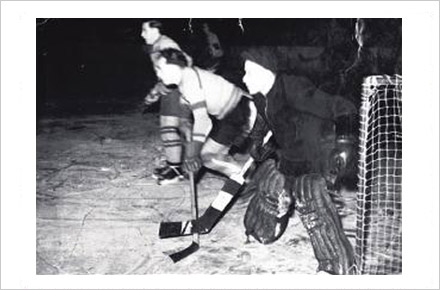
Toon van Rijswijk defends the goal in 1948 in the cap that made him instantly recognisable. He played until 1966. [12]
Toon and Joop were foundation players for TIJSC in 1938, and again when they were crowned Eredivisie champions for the first time in 1946-47, the inaugural season of the top Dutch league comprised of three Belgian clubs and three Dutch. Tilburg were the Netherlands' national champions in 1948. In 2013, exactly 75 years after the club was founded, a bronze cast of Toon was unveiled. "I walked around here for so long. I think it's great that they have honored me in this way," he told the local press on the occasion.[9] Today he is a penalty timekeeper at youth competitions seated in comfort on the official penalty bench named after him.
His goalkeeping career was not so comfortable — he was always at a power disadvantage because he was only five feet tall. "A big opponent pushed me without too much trouble to the other side of the net," he said. [8] Nonetheless, he got the keeper spot in the very first team, which was difficult for his netminder brother, Louis. "I was more agile, faster and probably more brutal," he said with a big smile on his face. "Louis then just went riding." [8]
Frans first coach, Andreola, started as a private in the Canadian army but left with captain's bars and the offer to play professional hockey in the Netherlands, where he had served during the war. He became fluent in Dutch as a player-coach during his days there. "The owner of the rink in Amsterdam asked if I was interested in playing and coaching," he said. So after being sent home for discharge, he returned abroad in November 1946. As a professional, one of two allowed on each team, he led the team in scoring three straight years. [10]
"I was also teaching young kids ice hockey at six in the morning," he said, and sign language didn't cut it. "It took me about a year and a half to be fluent." Standing on the ice after his last professional game and leading the team to its third straight European Baker Cup, "I gave a 10-minute speech at the rink in The Hague, all in Dutch," he said. "That brought the house down." [10]
When Frans turned sixteen in 1948, he played forward for the Trappers. The next season he played with Dick Groentemann who later emigrated to Sydney, Australia. At the age of eighteen, Frans was selected to play with the Dutch National Team at the 1950 World Championships in Paris. The next year, the rink on Elzenstraat was closed and the new rink in Theresia parish did not open until 1963. Granted army leave to practice, Frans was again selected to play in the 1953 World Championships in Zurich and Basel in Switzerland. Turning to study and work, he married Dimphinia Maria in 1956 at the age of 24 and had two children, Marie Louise and Frank. He remained at the Trappers until 1962, the year before the new Tilburg rink opened, then moved his young family to Australia the year he turned thirty. Tthe horror of a war-torn childhood was by then a distant memory. [2]
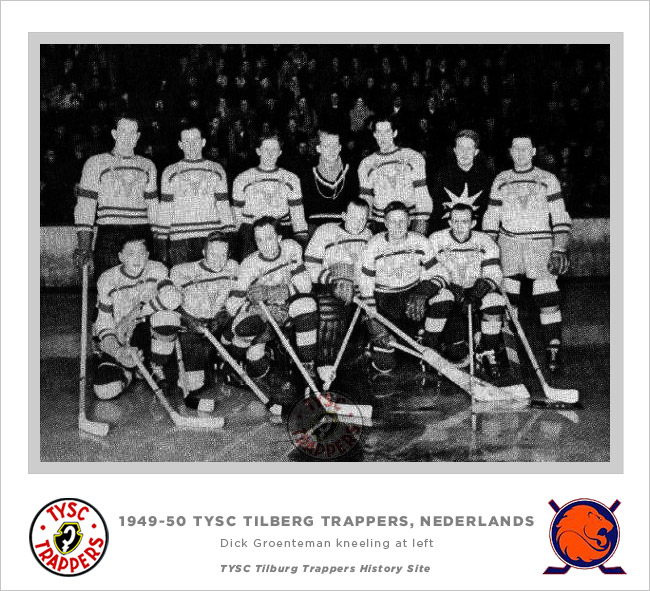
The Trappers with seventeen year-old Frans and Dick Groentemann, 1949-50
He became a production manager at Windmill Windows in Melbourne and played three seasons with the Pirates IHC at the St Moritz rink in St Kilda. Two more seasons followed as captain of the Pirates B-Grade team when the club relocated to Ringwood, where Fran's son joined the Junior Flyers. After Frans retired from playing, he became their coach, and won the 1973 premiership in his third season. The following year, he was coach of Victoria's junior ice hockey team. [2]
Franciscus Adrianus Antonius van Rijswijk died at Ringwood in Melbourne on October 9 2014, the year after his wife, Maria. They are interred at Lilydale Memorial Park. [11] Frans was 82 years-old and survived by his son and daughter, grandchildren Robert and Candice, Aaron and Sarah, Bree and great grandchildren John, Cheyanne, Justin and Xavier. [3] Joop had died in Tilburg in 1998 where his brother, Toon, still does the penalty box.
Bert Andreola is now a resident of Cinnaminson, New Jersey. A friendship during World War II eventually blossomed into ABC Plastic Fabricators there, specializing in lettering for signs and fabrication. But, well into his nineties, he still returned to his birthplace at Fort William to compete in the Celebrity Golf Classic, the tournament he won in 1968, and again in 1972. He was 75 on the first day of the 1994 USGA Senior Amateur championship, and still holds the record for the "Oldest Qualifer for Championship".
An original NHL Flyers' ticket holder, he lives just thirty minutes from the rink and, now and then, even invites players to dinner. [6] He credits his longevity to the advice coach Ed Lauzon gave players who wished to stay with the team in 1937. No. 1, Never say the "F" word, it's disrespectful. No. 2, People who smoke are fools. No. 3, Drink two glasses of water after every game and when you're old enough to drink, never mix and never have more than two. [6]
Remarkably, Tilburg was liberated with little damage and the historic city of Schiedam also suffered relatively little damage, despite the bombings. The bombed-out centre of the beautiful city of Rotterdam was gradually rebuilt from the 1950s.
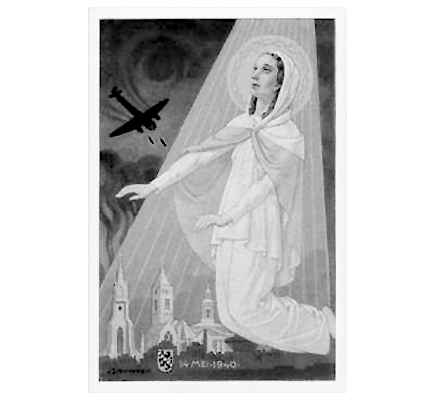
Devotion Print with a colored drawing of Schiedam Liduinastraat that protects during the bombing of Rotterdam, after a painting by J. Schmiermann, 1946. Bin collection.
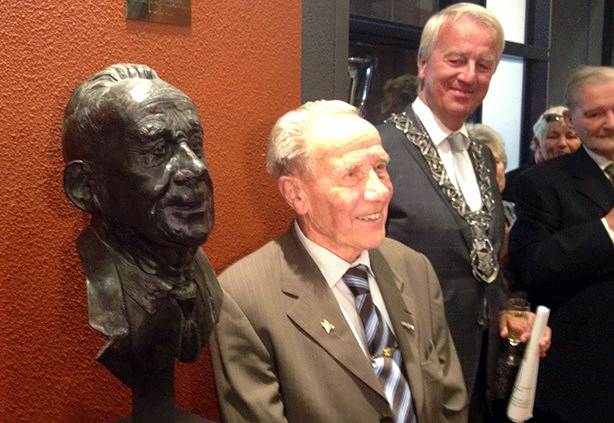
Toon van Rijswijk and the TIJSC 75 Year Jubilee bronze cast. Photo by Floyd Aanen.

TIJSC Home Ice, 1938. Entrance to van Rijswijk's IJsbaan on Elzenstraat, Tilburg's first engineered ice rink. Image source not known.
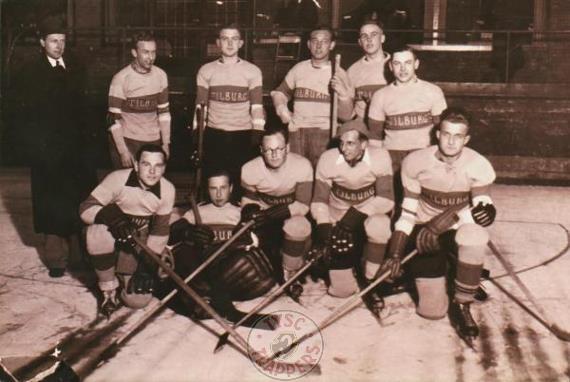
TIJSC season 1938-1939. In the photo sitting: Anton van Rijswijk (Toon). Others, right to left: F Koster, P van Bommel, F Koch, J van der Ven, G Lammers, J Essen Marijn E Schroeder, W Westendorp, Joop van Rijswijk and G Poos, courtesy TYSC Tilberg Trappers.

Joop and Toon, 1947-48 Eredivisie Champions, courtesy TYSC Tilberg Trappers.
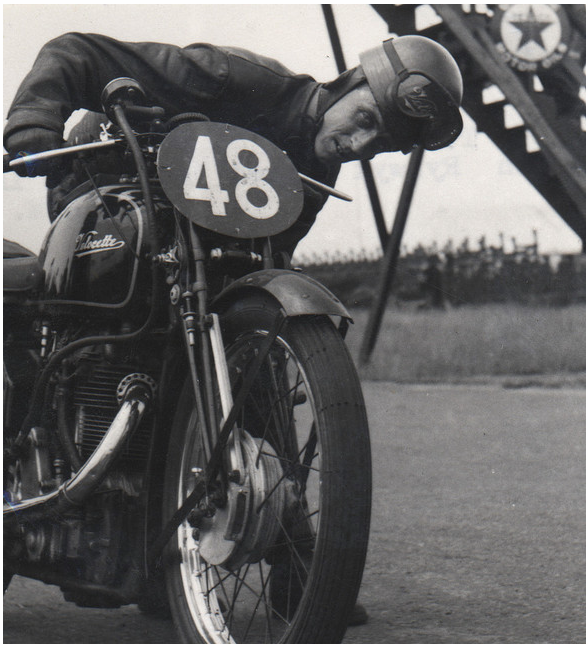
Louis H. van Rijswijk on 350cc Velocette, 1947 Dutch TT (Tourist Trophy), the biggest motor sports event in the Netherlands since 1925. Dutch TT collection in Assen.
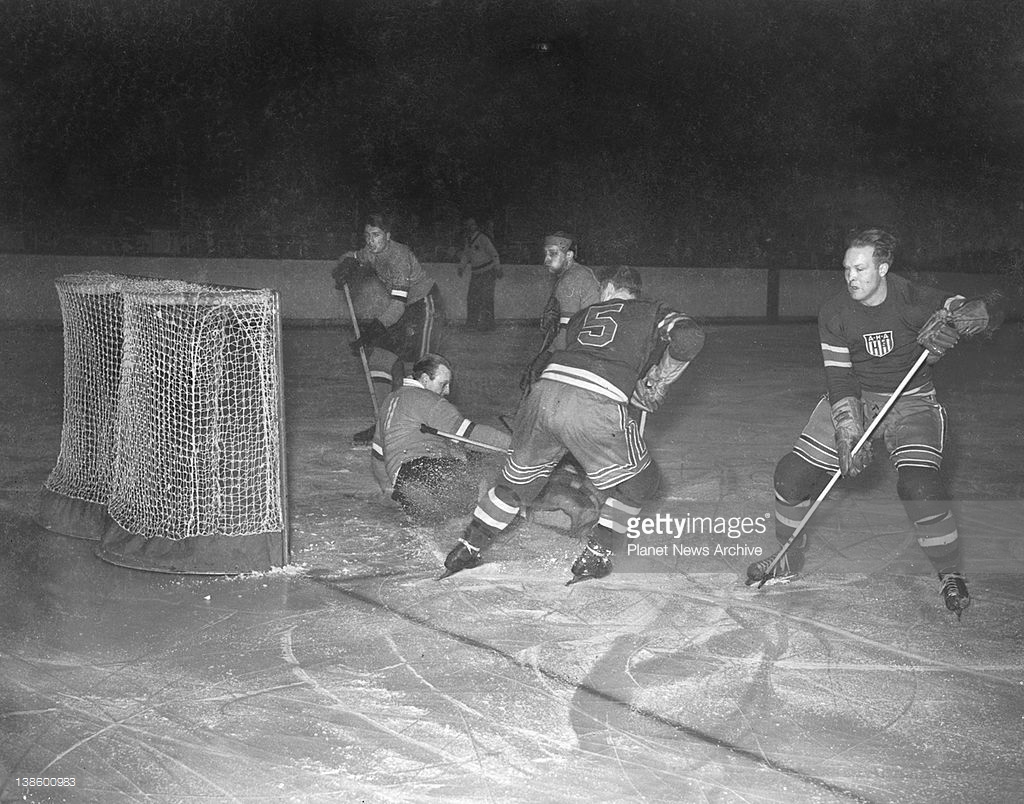
Frans and Netherlands in action against the USA in the 1950 World and European ice hockey championship at Harringay Arena in London. USA won an overwhelming victory, 17-1. Photo by Planet News Archive, SSPL, Getty Images
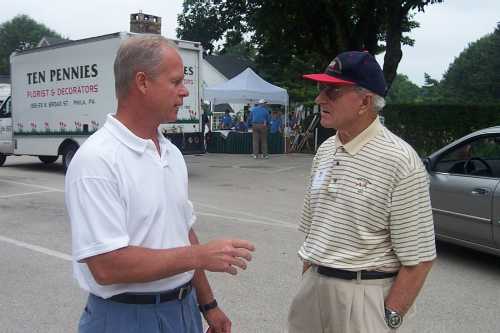
Andy Andreola (right) and Mark Howe at the 2004 Gene Hart Memorial Golf Outing. Ten years prior, Andreola was the oldest person to ever qualify for the seniors tour at age 75.
Citations:
[1] TYSC Trappers History Website, All-time Top Scorers List, August 1938 - April 1964. Last accessed 31 Mar 2015.
[2] 1974 Goodall Cup Series Melbourne, Program, Pen Portraits
[3] Herald Sun, Melbourne, 13 Oct 2014.
[4] Destil Trappers, Wikipedia
[5] Philly.com, On Ice Or Greens, He Has 5 Decades Of Athletic Success, By Charlie Frush, Inquirer Staff Writer, 1 Aug 1990
[6] Chronicle Journal, Thunder Bay, Ontario, August 3, 2007. Still Swinging by Mark Brody
[7] Port Arthur News Chronicle, 6 Nov 1970, Lakeheader "Big" In U.S. Plast
[8] TilsbugseKoerier, 2012, "Former Hockey Goalie Toon van Rijswijk (89) Skates Still" by Anita van Hassel (translated)
[9] Omroep Brabant, 21 Oct 2013, Distil Tilburg Trappers celebrate 75th anniversary in style, by Floyd Aanen
[10] Philadelphia Flyers history website, last accessed 31 Mar 2015, online
[11] Lilydale Memorial Park, Deceased Person Register, The Greater Metropolitan Cemeteries Trust
[12] Tilburg Trappers 75 Year Hockey History, 2013, Brabants Dagblad, Netherlands (translated)
(Slideshow above) Video of skating during the closing ceremonies of Rijswijk's first Tilburg rink on the Elzenstraat in Tilburg, 1943.
(Slideshow above) Image: The Hunters in the Snow (Dutch: Jagers in de Sneeuw) by Pieter Bruegel the Elder, 1565. In the distance, figures ice skate, play hockey with modern style sticks and curl on a frozen lake; they are rendered as silhouettes.
